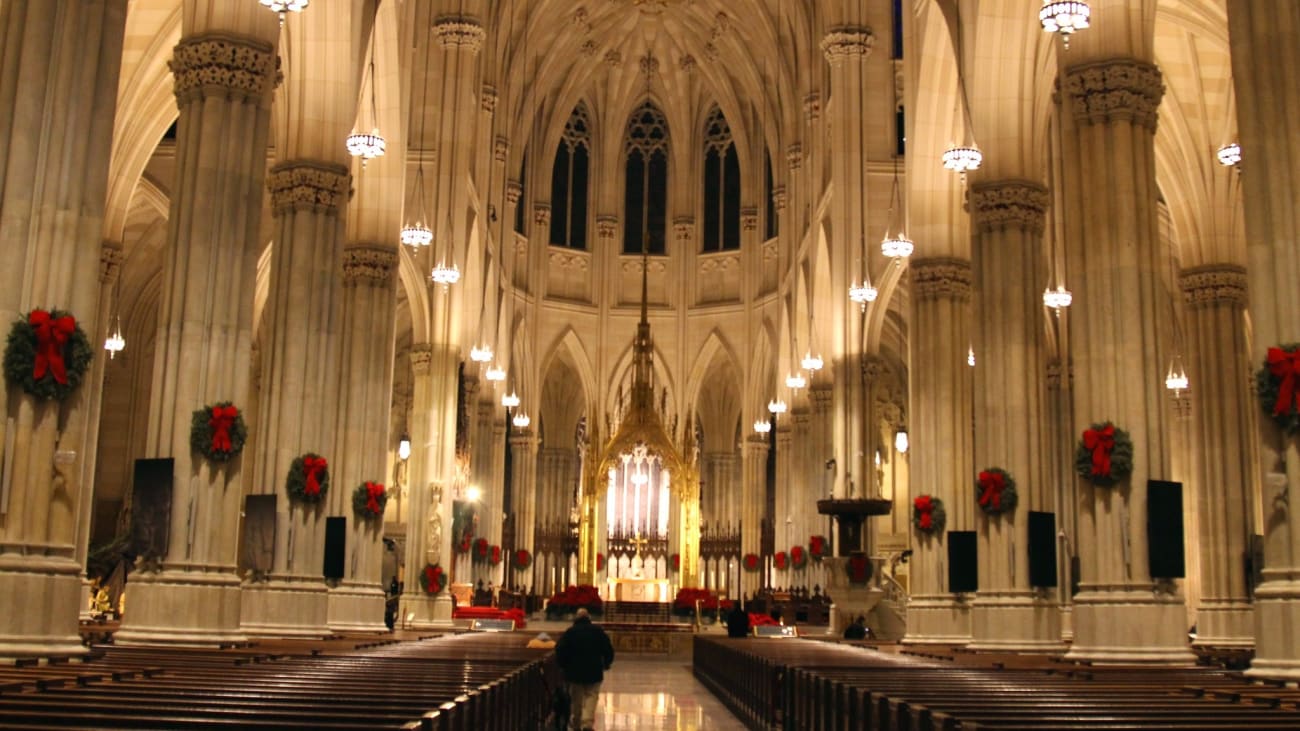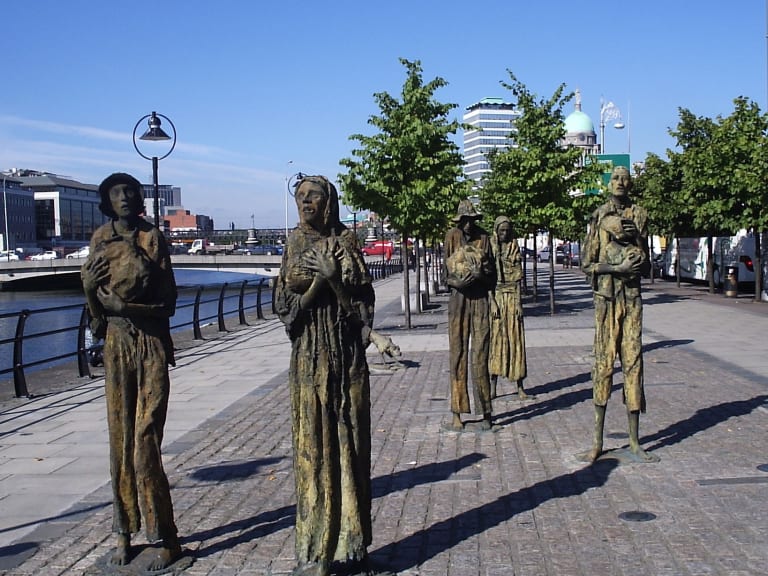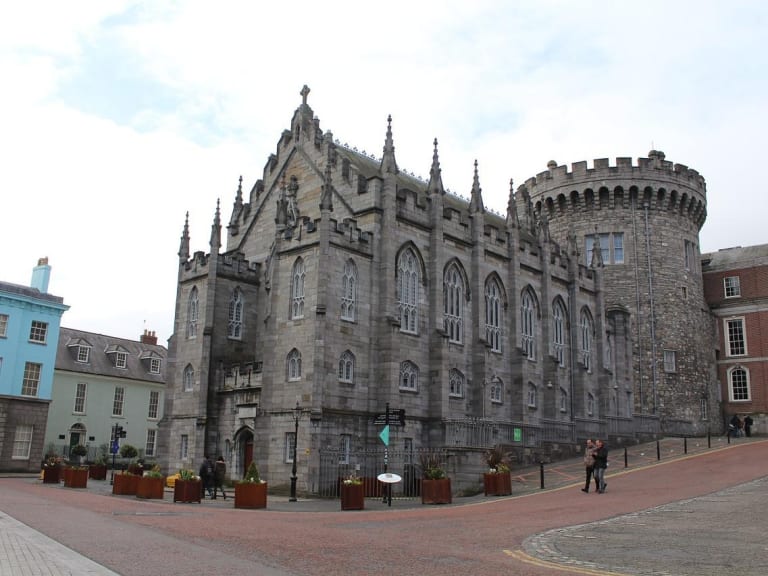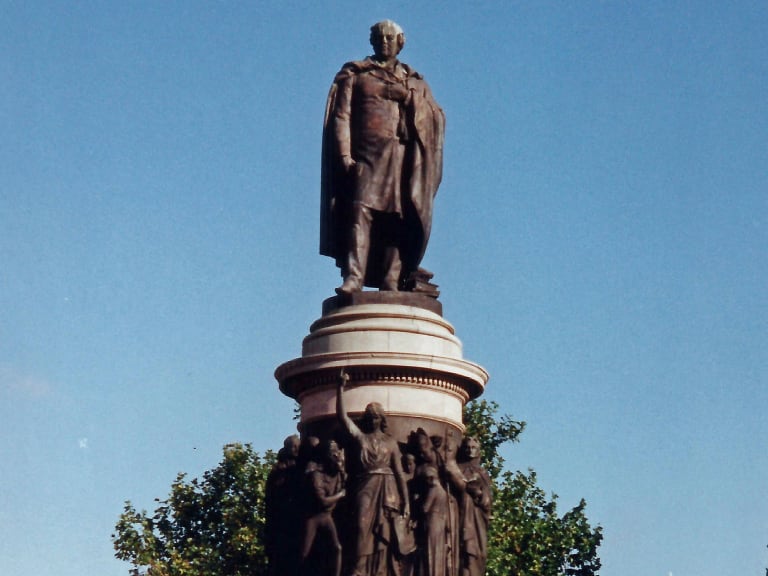10 Best Monuments in Dublin
Although it is not very big, Dublin offers its visitors several really impressive monuments. What can't you miss in Oscar Wilde's city?

Inside St. Patrick's Cathedral | ©Prayitno photography
When planning what to see and do in Dublin it is mandatory to take into account the monuments that the city houses. In the case of the Irish capital, you will find several really interesting ones, from those linked to its turbulent (and sometimes sad) history to the religious temples found in its streets.
We have prepared a decalogue with the ten most outstanding monuments in Dublin. The first point of the list is located on the banks of the River Liffey and a few meters from EPIC, the Irish Emigration Museum.
1. Discover the Famine Memorial

The Great Famine of 1845 was the most fateful historical event in Irish history. In that year, a fungus called "Phytophthora infestans" destroyed the country's potato crop and its effects lasted until 1852.
Irish leaders asked the British to repeal the "corn law", a tax on wheat that greatly increased its price. It was not enough and the famine took the lives of thousands of people, while many others had to leave the island forever.
The Famine Memorial commemorates all the men and women who left Ireland to seek a better life on the other side of the Atlantic. The sculptures depict people with haggard faces as they walk beside the river. The work is signed by Rowan Gillespie and is located under the Custom House, the old customs house of the port.
- Visiting hours: open air
- Price: free
- Where: Custom House Quay, North Dock, Dublin
2. The Castle, a fortress with a lot of history

Its origins are somewhat uncertain, although it is thought to have been an ancient Gaelic fort. Subsequently passed into the hands of the Vikings and the British, who kept it until the independence of Ireland.
Crossing the threshold you can visit the throne room, St Patrick's Hall (the old ballroom) and the state apartments, among others. It also has a bar (The Terrace Café) and a gift store.
The fortress is open every day of the week from 9:45 to 17:45 (last access at 17:15). The entrance fee is around 8 € although there are discounts for children and seniors over 60. If you want to save money, you can consider buying the Dublin Pass, a tourist card that includes tickets to several attractions in the Irish capital.
- Visiting hours: Monday to Sunday and public holidays, from 9:45 am to 5:45 pm.
- Price: adults 8,00 €, over 60 and students 6,00 €, children (between 12 and 17 years old) 4,00 €.
- Where: Dame Street
3. The bronze figure of Molly Malone

Molly Malone is the title of a popular Irish song and a famous statue at the foot of St. Andrew's Church. But who was Molly Malone? According to legend, by day she sold cockles and mussels in the streets while at night she was a woman of gallant life.
Known for her great beauty, she met a tragic death. Some think it was due to a high fever, others to a disease she contracted from a customer.
It is not known for sure if she really existed, but what is certain is that she has become a symbol of Dublin and therefore of Ireland. Her statue was designed by Irish sculptor Jeanne Rynhart and has occupied this corner of the city since 1988. Molly Malone is portrayed in the act of pulling a cart with wicker baskets. These baskets contained cockles and mussels, the seafood Molly used to sell in 17th century Dublin.
The song that tells her story is an Irish pub classic and has been performed by artists such as Sinead O'Connor, U2 and The Dubliners. Unlike what you might think, it was not composed on the island but in Edinburgh.
In the intentions of its creator - Scotsman James Yorkston - it was a humorous song but it was so well liked in Ireland that it has become the country's unofficial anthem. It is also known as "In Dublin's Fair City" and "Cockles and mussels".
- Visiting hours: open air
- Price: free
- Where: Suffolk Street
4. The Cathedral dedicated to St. Patrick

Any two or three day trip in Dublin should include it. St. Patrick is the patron saint of Ireland and the main church in the capital is dedicated to him. The first wooden church was founded in 1191 although the present cathedral was begun around 1220. The cathedral is notable for the wonderful Gothic style and the tomb of Jonathan Swift, the author of "Gulliver's Travels".
In addition to masses, the Dublin church organizes classical and contemporary music concerts. To keep abreast of events, I recommend you take a look at the official website.
In the surroundings of the cathedral you will find different bars and restaurants. If you fancy fish & chips, I recommend you to go to the Ritz Cafe (Patrick Street 3, Dún Laoghaire).
- Visiting hours: Monday to Friday, from 9:30 am to 4:30 pm. Saturdays, from 9:00 to 17:30 and Sundays from 9:00 to 10:30, from 13:00 to 14:30 and from 16:30 to 17:30.
- Price: around 8 €.
- Where: St Patrick's Close
5. The memorial to Daniel O'Connell

Daniel O'Connell, nicknamed "The Liberator", was the first great nationalist leader of the 19th century. If Ireland has gained independence from the United Kingdom, part of the credit is due to him. Thanks to his charisma he managed to unite the people and to guarantee greater rights to the Catholics. He was not in favor of violence and his thinking influenced many supporters of independence.
Daniel O'Connell is a beloved figure, so much so that Dublin's main thoroughfare is named after him. At the end of the street, a few meters from the river, stands a bronze monument dedicated to him.
Designed by John Henry Foley - one of the best sculptors of his time - it has stood guard over the Old Town since 1882. If you look closely, you will see bullet holes dating back to the Easter Rising, the Irish rebellion of 1916.
- Visiting hours: open air
- Price: free
- Where: O'Connell Street Lower
6. The GPO, the post office

The General Post Office was the last Georgian-style building constructed in the city. Its imposing facade dominates O'Connell Street and is still in operation today.
In addition to its architectural importance, it is notable for its "role" in the 1916 Easter Rising. More than a century ago, the office was the headquarters of the mutineers. Although the rebellion ended in failure, it was crucial to achieving Irish independence.
For just under a week, the rebels occupied the building until they were forced to surrender. To delve deeper into the history of the uprising, I recommend booking a visit to the GPO Museum. If you travel to Dublin in December you can enjoy the Christmas Experience organized by the cultural institution.
- Visiting hours: Wednesday to Saturday, from 10:00 to 17:00
- Price: about 13 €.
- Where: O'Connell Street Lower
7. The life-size statue of Oscar Wilde

A short distance from Trinity College, a life-size figure depicts the writer as he rests on a rock. The statue is located in Merrion Square Park and has a peculiarity: the face expresses two contrasting feelings. The left side shows a happy face, while the right side has a sad expression. This feature symbolizes Oscar Wilde's departed soul
The statue faces the old Wilde family home at 1 Merrion Square. The writer was fortunate to be born into a wealthy family and his residence was the epicenter of Dublin's cultural life.
The house can be visited and the tour includes the bookshop and the main hall where Lady Jane Wilde celebrated her famous soirees. For more info, I recommend you to visit the official website.
- Visiting hours: open air
- Price: free
- Where: Merrion Square Park
8. Glasnevin Cemetery, the first catholic cemetery

North of Dublin is the resting place of millions of Irish people. The nationalist leaders Arthur Griffith, Michael Collins and Daniel O'Connell, the revolutionary suffragette Constance Markievicz, the poet Brendan Francis Behan and other influential people are eternally buried here.
Glasnevin Cemetery is huge - it measures more than 120 acres - and its graves reflect the changes in tastes and styles over the centuries.
Monday through Sunday, walking tours will reveal the cemetery's secrets. Tours begin at the Museum's reception area, usually last an hour and a half and are led by experienced tour guides.
To get to the cemetery you have several options and the most chosen by tourists is the tourist bus that stops near the entrance. Another option is the city bus (lines 4, 9, 40, 83, and 140) or the suburban train (DART, Drumcondra stop).
After a walk, you can have a drink at SI Café - The Tower which is located just a short walk from the O'Connell Tower (Glasnevin Cemetery, Botanic). Another option is John Kavanagh - The Gravediggers, a family pub opened in 1833. It maintains a separate area that was once dedicated to women (don't worry, nowadays anyone can sit there) and no calls or music are allowed (Prospect Square 1).
- Visiting hours: open daily from 9:00 am to 5:00 pm.
- Price: the tour that goes through the cemetery and delves into Irish history costs around 13 €.
- Where is it: Finglas Road, Glasnevin
9. The Spire, the spiral that reaches up to the sky

In the middle of O'Connell Street, and within walking distance of the General Post Office, stands a modern steel obelisk. It has a height of 120 meters and is the tallest structure in the old town.
Also known as An Túr Solais (Monument of Light), it does not commemorate anything specific: it is simply a gigantic meeting point in a commercial area.
In the past, a large granite column topped by a statue of Horatio Nelson stood on this very site. The monument was unveiled in 1809, just after his victory at Trafalgar. After the independence of Ireland, the citizens wanted to replace Nelson with an Irish patriot, but the city council could not make up its mind. Finally, the Republican army blew it up in 1966.
If you pass by O'Connell Street at lunchtime and you fancy a traditional dish washed down with a pint of Guinness, I recommend going into Brannigan's (Cathedral Street 9). This historic establishment is the place to order Bangers & Mash, pork sausages served with mashed potatoes seasoned with cheddar cheese, leeks and caramelized cabbage.
- Visiting hours: Open air
- Price: Free
- Where: O'Connell Street Upper
10. Sphere Within A Sphere, a work by Arnaldo Pomodoro

It was donated to Trinity College in 1992, which placed it in front of the bookstore. It is a large metal sphere with a cracked surface that reveals another cracked sphere inside.
According to the artist, the inner ball represents the Earth while the outer ball represents Christianity. He has sisters in Pesaro, Rome, Washington, New York, Tokyo and Tehran.
- Visiting hours: open air
- Price: free of charge
- Where: Trinity College
